
Synopsis: In this article we will learn about the details of how to practice Sun salutation and its effect on our Solar Plexus. The article also includes a pictographic explanation of the 12 poses for one round of Surya Namaskar, along with the Mantras and it’s meaning that are spoken with each pose.
Regular and sustained practice of Surya Namaskar or Sun Salutation, together with the right diet helps one live a healthy and long life. Two rounds of twelve asanas in Surya Namaskar, correspond to the movement of the sun in a 24-hour cycle.
There are five basic elements present around and within our bodies. These are ether (space), air, fire, water, and earth. The fire element is that which is the energy conversion factor in all forms of life and is a support of the universe in its microcosmic aspect. It is very extensive as well as all inclusive in different forms at all levels to help us sustain life. This fire element is represented by the Sun.
SOLAR PLEXUS – MANIPURA CHAKRA
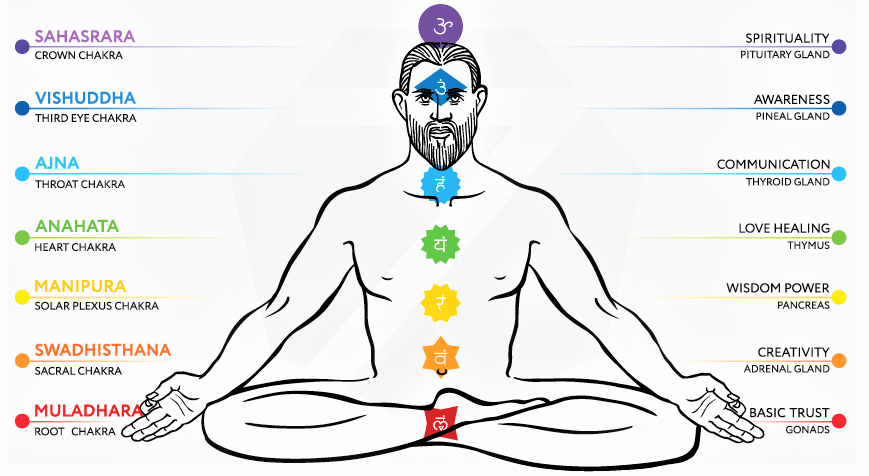
The Asana sequences in Surya Namaskar are aimed at energizing the energy centers (Chakras) in the body, especially the Solar Plexus or the Manipur chakra, at the navel. The solar plexus is located behind the navel in the human body and is connected to the Sun. It is associated with the fire element and represents purpose, courage, and self-confidence. It is popularly called the gut instinct or the second mind. Our solar plexus is related to the vagus nerve, the tenth cranial nerve and the longest of the autonomic nervous system which is responsible for the body’s subconscious functioning such as breathing, circulation and digestion. It also governs our happiness, mental stability and social relationships.
The practice of 12 postures of the sun salutation series enhances the solar plexus which, in turn, increases creative, intuitive, and leadership abilities in the practitioner Surya Namaskara awakens the sun’s healing power in the solar plexus and gives a clear, calm, and determined mind. It also helps stimulate the digestive fire, energize the nervous system, balance the pranic flow and and positively influence the mood and emotions.
Video Link: Surya Namaskar with Mantras
BEST TIME TO PRACTICE
Surya Namaskar gives best results when done during very early sunrise. Depending on the season (summer or winter), the best suggested time is around 5 am or when the first rays of sun start to faintly appear in the sky. Surya Namaskar in the morning revitalizes the body and refreshes and balances the mind, preparing one to take on the rest of the day with optimal physical and mental health. When done at dawn, it is advised to practice the asanas on an empty stomach. The sun is the most healing and calming with soft rays providing maximum benefit to the mind-body and soul.
NUMBER OF REPETITIONS
One can start Surya Namaskar practice with 2-3 rounds (cycle of 12 asanas comprise 1 round). Gradually they can increase to 12 – 24 – 48 rounds, depending on their strength, endurance and availability of time. The asanas keep the practitioners joints and spine supple, keeping the usual age related issues at bay and help them live a long and healthy life.
ASANAS AND MANTRA IN SURYA NAMASKAR
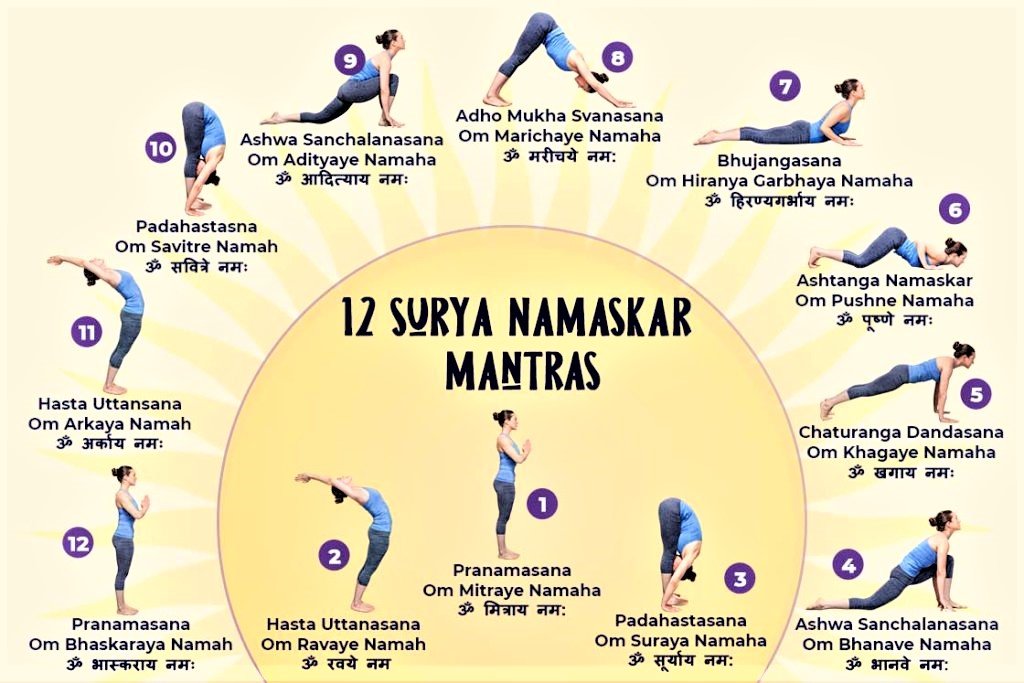
Surya Namaskar consists of 12 yogic asanas that are performed in a sequence. The 12 asanas complete one cycle of Surya Namaskar. Two cycles complete 1 round. In the first cycle, the right side of the body is predominantly used, while the left side is used for the second cycle.
The 12 yogic positions during the practice of Surya Namaskar activates the Pingala (Sun channel, right nostril-sympathetic system) to give physical energy and a dynamic start to the day. The left side movement activates the Ida (moon channel, left nostril, parasympathetic system) to create a meditative spiritual practice. Ideally, both sides are used in tandem during a round of two cycles, to create a harmonious flow of energy through the sympathetic and parasympathetic systems. Thus it brings awareness of consciousness through the planned movement of the physical body.
The 12 asanas in one cycle and their benefits are explained below :
1. Pranamasana (Prayer Pose): Surya Namaskar begins by greeting the Sun God in a prayer position while standing upright. It helps in calming down the body and mind.
Mantra: ॐ मित्राय नमः Om Mitraya namah. Meaning: One who is a friend to all

2. Hastauttanasana (Upward Salute): In this asana, hands are gradually lifted and the back is bent backwards. Slowly inhale air and bring the biceps close to the ears. The asana helps in stretching the chest as well as abdomen muscles and surges the energy flow towards the upper part of your body.
Mantra: ॐ रवये नमः Oṁ ravaye namaḥ. Meaning: The shining one, the radiant one

3. Padahastasana (Hand to Feet Pose): After stretching the abdominal region, this asana massages the belly. Doing this improves digestion while also enhancing the blood flow to the brain. Exhale, bend, and try touching the floor with the hands while keeping the spine straight. Make sure to exhale slowly.
Mantra: ॐ सूर्याय नमः Oṁ sūryāya namaḥ. Meaning: One who is the dispeller of darkness

4. Ashwa Sanchalanasana (Equestrian Pose): This asana stretches the spine further along with quadriceps and iliopsoas muscles. It also stimulates the digestive organs. After Padahastasana, start bending your knees towards the right (alternate with right and left leg between cycles) side of the chest while moving the left leg backwards. Raise the head and look forward. Also, inhale throughout.
Mantra: ॐ भानवे नमः Oṁ bhānave namaḥ. Meaning: One who illumines and enlightens
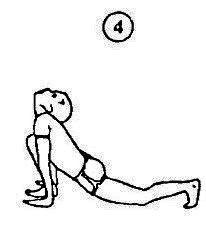
5. Phalakasana (Plank Pose): This asana improves body posture and strengthens the back muscles and spine. It also exercises shoulder and chest. Move forward and perform a plank while inhaling. Make sure that both of the hands are just below the shoulders and the body is parallel to the ground.
Mantra: ॐ खगाय नमः Oṁ khagāya namaḥ. Meaning: One who is all-pervading
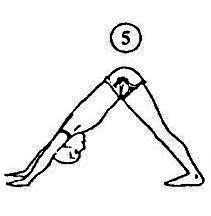
6. Ashtanga Namaskara (Salutation Pose): Ashtanga Namaskara asana helps in strengthening the chest, arms, and legs. Exhale and bring the chin down on the ground. Keep the hips up in the air. The chin, chest, hands, and knees must be on the ground.
Mantra: ॐ पूष्णे नमः Oṁ pūṣṇe Namah. Meaning: Giver of nourishment and fulfillment
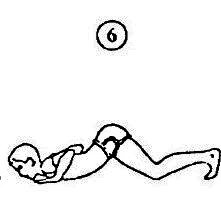
7. Bhujangasana (Cobra Pose): Slowly bring your hip down and place your legs as well as midsection on the ground while inhaling. Keep the head up and bend the back. The body posture will resemble a cobra in this asana. It relieves tension from the back and spine.
Mantra: ॐ हिरण्यगर्भाय नमः Oṁ hiraṇyagarbhāya namaḥ. Meaning: One who is radiant

8. Adho Mukh Svanasana (Downward Dog): This asana makes the arms and legs stronger and relieves varicose veins. It also stretches the calf and spine muscles. Breathe out and lift the waist to make an ‘inverted V’ with the body. Try to keep the heels flat on the ground.
Mantra: ॐ मरीचये नमः Oṁ marīcaye Namah. Meaning: The giver of light and luster
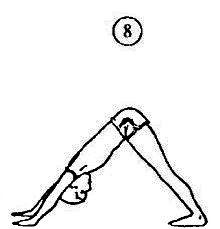
9. Ashwa Sanchalanasana: Repeat Ashwa Sanchalanasana by lunging with your left (alternate with right and left leg between cycles) leg forward.
Mantra: ॐ आदित्याय नमः Oṁ ādityāya Namah. Meaning: The son of Aditi, the cosmic Mother
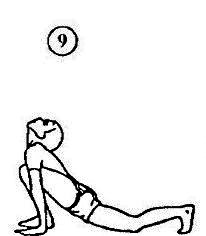
10. Padahastasana: Repeat Padahastasana.
Mantra: ॐ सवित्रे नम Oṁ savitre Namah. Meaning: One who is responsible for life

11. Hastauttanasana: Repeat Hastauttanasana.
Mantra: ॐ अर्काय नमः Oṁ arkāya namaḥ. Meaning: One who is worthy of praise and glory
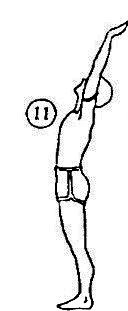
12. Pranamasana (Prayer Pose): Repeat Pranamasana
Mantra: ॐ भास्कराय नमः Oṁ bhāskarāya namah. Meaning: Giver of wisdom and illumination
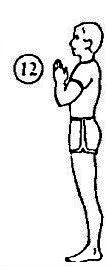
Check out the first part of the article : Scientific Benefits of Surya Namaskar
Surya Namaskar should always be done with a synchronized breath with each move. All the limbs and core are engaged during the asanas. The inhalation and exhalation are matched with the expansion and contraction of the muscles in the body.
- RELATED ARTICLES
- Why Eating with Hand is Good for Health
- A True Genius, Inventor and Visionary : Nikola Tesla
- Ancient Strategy to Increase Brain Power

